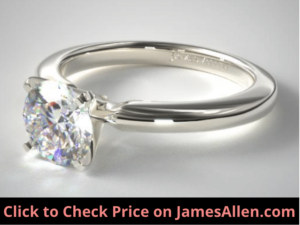Zales, Kay, and Jared are three of the most prominent names in jewelry.
Their recognizable brands are most associated with physical locations, but each has expanded their online stores to reach customers in a way that doesn’t require a visit to their stores.
My bottom line recommendation is that although you can expect tremendous, personalized service from those three vendors, you’ll find a better value and selection at an online jewelry store like James Allen.
It’s where I bought my wife’s engagement ring.
But let’s compare Zales versus Kay versus Jared in the areas important to your decision, including overviews of each company, their selection of jewelry, quality, prices, return policies, warranties, and more.
Zales Overview
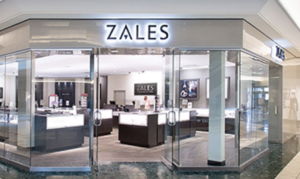
Zales was founded in Wichita Falls, Texas in 1924 by Ben Lipshy, Morris (M.B. Zale), and William Zale. The financing model distinguished it from the competition through offering a “penny down and a dollar a week’ on expensive jewelry.
The company now runs more than 700 stores that sell a variety of pieces, from engagement rings and bracelets to earrings and necklaces.
Zales was bought by Signet Jewelers, the world’s largest diamond jewelry retailer, in 2014.
They began closing many of its mall stores in 2017 in order to expand its online business, but Zales is still known for its in-store experience with huge displays.
The parent company documents its conflict-free sourcing methods in the Signet Responsible Sourcing Protocol.
Kay Overview
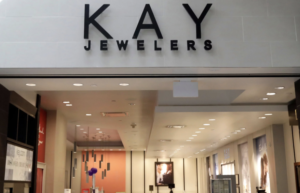
Kay was founded in Reading, Pennsylvania in 1916. Its first storefront was known for eyeglasses, music boxes, appliances, and silverware. Today, customers know the brand for its:
- Engagement rings
- Wedding bands
- Anniversary and fashion jewelry
- Necklaces, earrings, and bracelets
- Watches
There are close to 1,000 Kay locations around the world. Like Zales, the company often opens locations in high-traffic areas like malls and shopping centers.
This keeps the brand top-of-mind for buyers, who can connect with jewelry consultants to guide them through their purchase.
Its television marketing campaigns popularized the phrase “Every Kiss Begins with Kay.”
Kay was bought by Signet, which also owns James Allen and Blue Nile.
The company complies with the Kimberley Process, so its diamonds aren’t used to finance civil wars against legitimate governments.
Jared Overview
Jared The Galleria of Jewelry is also owned by Signet, making the parent company one of the world’s largest players in the jewelry industry. In total, Signet operates 3,600 stores, with more than 200 under the Jared name in almost every state.
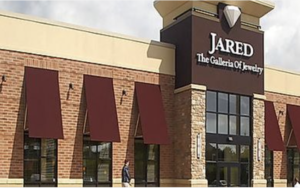
They aren’t located in shopping malls, but they’re generally placed nearby in standalone locations.
Founded in the 1990s, Jared was previously known for the slogan “He Went To Jared,” which emphasized the brand’s prestige. It targeted affluent customers, which is how it went on to sell more than one billion dollars in jewelry every year.
They have since updated that tagline to “Dare to Be Devoted” in its effort to appeal to younger consumers.
Like Kay and Zales, they’re committed to sourcing only conflict-free diamonds.
What are the Differences Between Zales, Kay, and Jared?
Jewelry Selection
All three companies have a wide selection of jewelry. This includes the number of product lines and the choices within those categories.
While Zales is nicknamed “the diamond store”, their inventory expands far beyond diamonds. For example, it has more than 11,000 types of necklaces listed on its website.
They include diamonds, morganite, sapphire, rubies, emeralds, and more than 10 other gems.
The images below are two of their rose gold rings.
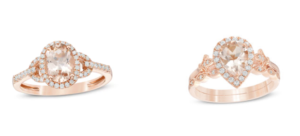
Both feature a halo of diamonds around the center one and demonstrate the unique designs offered by Zales. Notice how the accents are intricately placed on the shank as well, which allows the whole piece to sparkle when it’s twirled.
The company also sell rings that aren’t meant for engagements. The list includes cocktail, anniversary, wedding, and promise rings. Each of these styles comes in many designs.
Some of its anniversary rings are made with rose gold and include multiple rows of diamonds lining the shank, like the example below.
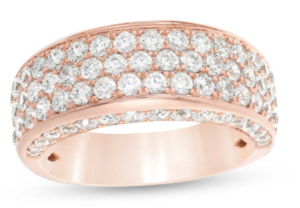
Others are complete with milgrain encircling small accents.
But Zales is most known for their diamond rings, and your options there aren’t in short supply. There are more than 8,000 available across 11 cuts.
So whether you’re searching for a princess cut in a prong setting, an Asscher cut in a solitaire setting, or a round cut surrounded by a halo, you’ll find it at Zales.
Kay offers almost all the same product lines as Zales. In fact, their main categories are nearly identical, with Kay promoting every type of jewelry from watches and bracelets to diamond rings and pendants.
And similar to Zales, they’re most known for diamond rings. You’ll find settings created with rose, white, and yellow gold or platinum.
They sell lab-created diamonds for those exploring more affordable options than natural ones.
The two lab-created diamonds from Kay below sell for a lower price compared to the same designs with natural diamonds.
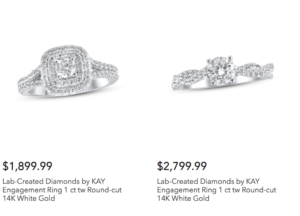
If you’re comparing Zales versus Kay in regard to selection, you’ll find more similarities than differences.
The categories of jewelry at Jared are similar. You’ll find:
- Engagement and wedding rings
- Charms and watches
- Necklaces, bracelets, and earrings
Within its selection of engagement rings, there are popular styles ranging from halo and side stones to solitaire and pave.
For example, their halo settings are available with almost every cut of diamond. Most buyers choose round-cuts, where the halo matches the outline of the center stone, but there are also engagement rings with Asscher and emerald cuts.
The ring below includes a halo around a cluster of round-cut diamonds.
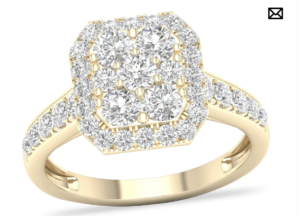
Combined with pave diamonds on the shank, it has a total carat weight of one carat but is priced lower than if the weight was only in the center diamond.
Jared also carries brands like Bel Colore, John Hardy, Le Vian, and its own signature collection.
Quality of Diamonds and Jewelry
You’d be mistaken if you judged the quality of a diamond by the retailer who sells it.
That’s true whether you’re buying from popular online brands or from a local retailer.
Instead, its quality should be determined by a credible third party who doesn’t have a financial stake in selling the diamond.
That’s why we recommend buying diamonds certified by the Gemological Institute of America (GIA), American Gem Society (AGS), and the Gem Certification & Assurance Lab (GCAL).
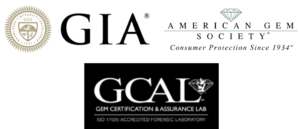
Most of Kay’s diamonds are certified by the International Gemological Institute (IGI). Although well-known for certifying diamonds, they also have a reputation of being more lenient with their grading than the GIA and AGS.
So you could pay more for the diamond because it received a higher color, clarity, or cut grade from the IGI than it would’ve received from the GIA or AGS.
Zales diamonds are often certified by the GIA or IGI.
For example this two-carat solitaire engagement ring earned an I color grade and VS2 clarity designation.
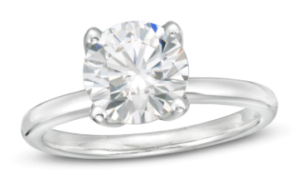
The image Zales provides of the diamond could be deceptive. It appears to be eye-clean, which means no inclusions are visible to the naked eye, and colorless.
A large diamond with a VS2 clarity grade may have visible inclusions, and the I color grade means it likely has a slight yellow tint. But that isn’t evident from the image.
Base your decision about the quality of a diamond on a reliable grading report instead of a stock image or the brand name of the vendor.
Jared sells diamonds from six grading labs, including the GIA and AGS. I recommend you select one of these options.
Not only are many of Jared’s diamonds graded by the most regarded institutions, the rest of their jewelry is known for quality as well.
It’s a luxury brand across all product categories. That’s why you’ll find names like Gucci and Citizen in their watch selection.
Zales and Kay do have other quality pieces of jewelry as well. Their extensive product lines within each category means there’s something for every taste.
All three companies have exceptional designs that go beyond a simple solitaire setting.
Zales’ wedding rings come in a variety of styles, but my favorite is the eternity band with round cut accents placed around the band.
I’ve posted an image of one below.
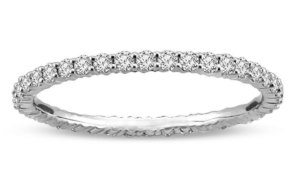
It takes the simplistic design of most wedding rings and adds sparkle to it. When it sits next to an engagement ring, the diamonds complement each other to create an exceptional pair.
There are also half-eternity rings, where the diamonds go halfway around the band.
Kay has designer collections in almost every category of jewelry that feature alternative pieces you won’t find at many retailers.
Jared offers an impressive lineup of bridal sets, so you can find the perfect match between your engagement and wedding rings.
But like any jewelry brand, the degree of quality in a Jared, Kay, or Zales piece of jewelry can depend on the piece. The first step is checking the diamond report and then understanding the craftsmanship.
Prices
It’s difficult to compare prices for Kay versus Zales versus Jared because it depends on the product line. You might find instances where wedding rings are less expensive at Zales, but necklaces run higher at Kay and Jared.
The companies also don’t always provide the grades across the four Cs, which means you can’t compare two diamonds that are the same quality.
But the best way to understand differences in price between the three brands is to find similar pieces. As an example, both Zales and Kay sell one-carat solitaire engagement rings in 14K white gold.
This ring from Zales with those qualities costs $6,999.99.
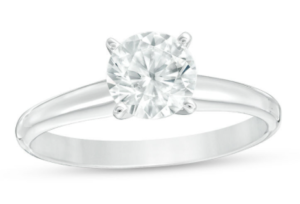
This one from Kay costs $6,999.99.
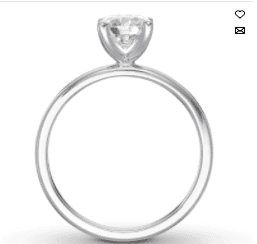
We created a similar engagement ring on Jared’s website, and it costs $6,568.
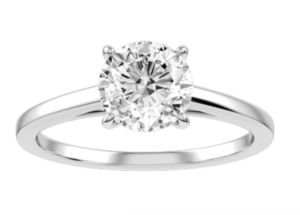
This shows that Jared, Kay, and Zales have similar pricing for diamond rings. One caveat is Kay doesn’t provide the diamond’s grades, while the Zales and Jared diamonds earned I color and SI2 clarity grades.
If the Kay diamond earned higher or lower grades in color or clarity, that would mean they aren’t priced the same.
But the three retailers are significantly more expensive than other online diamond stores.
For example, we can create a similar diamond ring at James Allen.
We chose a 14K white gold solitaire setting and a diamond with the same grades as the one from Zales and Jared.
Its total cost is $3,570, which is less than half of what you’d pay at the three retailers.
So although Zales, Jared, and Kay often have comparable pricing, it far exceeds what you’ll pay when jewelers don’t have the overhead and marketing costs associated with brick-and-mortar stores.
You’ll have to weigh the pros and cons of higher prices at those three retailers and decide whether the personalized service and ability to shop in-store is worth the premium.
In-Store Experience
Zales, Jared, and Kay promote their in-store experiences that draw shoppers in by showcasing all types of jewelry.
If you walk into any of the three stores, you’re sure to be greeted by a jewelry consultant, who can answer any questions you have about the experience.
During my visits to the three retailers, I’m always impressed by the range of pieces they have on display.
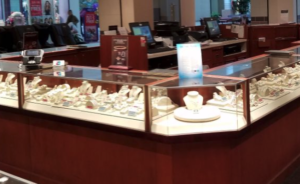
I’ve shopped for various types of jewelry, from necklaces and earrings to gift and a quick browse for an engagement ring.
Although online vendors have enhanced their experiences with high-resolution images, there really is no substitute for viewing a piece up close and personal.
It’s most helpful if you’re searching for a diamond. When you’re in the store, you don’t have to guess whether it’s eye-clean based on the grading report and image.
The evidence is right in front of you.
The other benefit to Zales’, Kay’s, and Jared’s in-store experience is the services they offer.
For example, my wife’s engagement ring needed resizing. Jared provides those services. We took the ring in, and their representative confirmed the size she needed.
The next day, we picked up the resized ring, and it fit perfectly. We didn’t have to worry about shipping the ring to and from and online vendor and had full confidence in the experience.
Online Shopping
Zales, Kay, and Jared are known for their physical storefronts with flashy marketing and large display cases.
But the three brands have expanded their online presence as more people have become comfortable buying jewelry online.
This doesn’t mean the quality of their online shopping experience has caught up to their competition.
The sites allow you to design your own engagement ring, where you choose a diamond and setting, and they’ll pair them together.
But the experience at Zales and Kay is limited.
For example, when selecting a diamond, your options for carat weight go up in increments of 0.25 carats. There’s a significant price jump as you move up this scale, as opposed to choosing a carat weight in between.
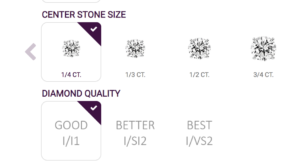
Your choices for color and clarity also have limits. The options on both sites are:
- I/I1
- I/SI2
- I/VS2
I1 and SI2 diamonds often have visible inclusions. And ones with an I color grade may have shades of yellow.
Kay and Zales also use low-quality images. Other online jewelry stores use high-resolution images so you know exactly what to expect before you buy.
This matters less for pieces like wedding rings or necklaces, where there isn’t a prominent center diamond.
But overall, the online buying experience for Zales and Kay can’t compete with others in the space.
Jared is the exception. They’ve designed their online experience similar to James Allen. The best feature is the ability to create your own engagement ring by selecting the exact diamond and setting.
You can filter your choice by criteria including:
- Shape
- Cut
- Color
- Carat
- Clarity
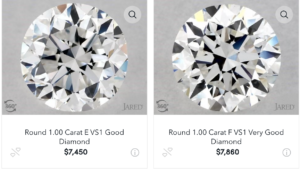
You’ll know the exact quality of your diamond and the settings it matches.
If you’re buying a diamond ring from Jared online, we recommend using this tool.
Packaging
You should also consider the jewelry packaging as part of the experience, especially if you’re ordering the piece as a gift.
Zales diamond rings often come in a silver box with a soft interior.
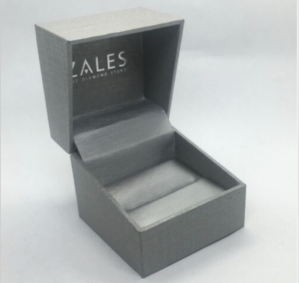
It’s perfect for a proposal and to store the ring.
Other types of jewelry use different packaging. If you choose a piece from one of their collections, it often has a box unique to that brand.
Their bracelets and necklaces come in long silver boxes with the Zales name on top.
Kay’s packaging is a similar style. The engagement rings often come in red, black, or blue, with a cushion interior and the brand name on top.
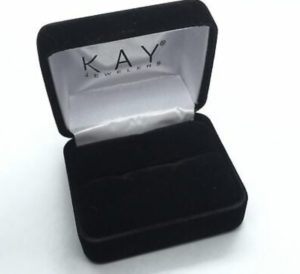
Use it as part of your proposal because of its compact size and elegance.
For some bracelets and necklaces, expect a rectangular box with the same interior.
Jared’s jewelry packing for diamond rings is a brown box with a white ribbon. The brand name is located on the inside, so it reads “Jared The Galleria of Jewelry.”
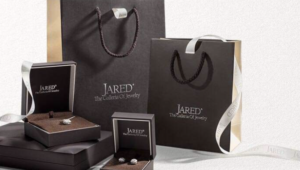
For necklaces and other jewelry, they often come in a long, rectangular box that mimics the style of the diamond ring packaging.
If you’re gifting any of their jewelry, you don’t need a separate box. You can simply wrap the packaging it already comes in so you keep the luxurious aesthetic.
Shipping, Return Policies and Warranty
Don’t ignore shipping, return policies, and warranties from jewelry vendors.
Fortunately, Zales, Kay and Jared pass the test across all three areas.
Kay offers free shipping for orders more than $50, or you can pick up items in the store.
At Zales, there’s no minimum purchase for free shipping, and in-store pickup is available. There’s an extra charge for expedited shipping between $6.95 and $21.95.
Jared offers free UPS 2nd Day Shipping on non-personalized orders in stock, but there are some exceptions, which you can read here.
They’ll also ship your jewelry to any Jared location for free, with no minimum purchase required.
The companies also have similar return policies. You can return most pieces for a full refund for 30 days, or if you plan to exchange the item for an upgrade, that deadline extends to 60 days at Zales and Kay.
Also consider the warranties and service plans.
Kay’s gemstone and diamond guarantee states your stone should last forever, but they must inspect it every six months.
The policy says they’ll replace any stone if it chips, breaks, or is lost from its original setting through normal wear.
You can read their full guarantee and its exclusions here.
Zales offers a lifetime protection plan that includes:
- Cleanings
- Inspections
- Ring sizing
- Prong and stone tightening
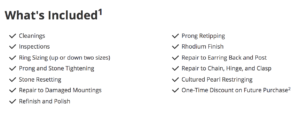
There’s a complimentary plan for every purchase of $200 or more, or an add-on policy that includes diamond replacement and doesn’t require the in-store inspection.
You can read the details of their warranty here.
Jared includes a Lifetime Diamond & Gemstone Guarantee for its jewelry, and there’s the option to purchase an extended service plan.
Also check out the warranty policies for the specific brand. Many of the brands the companies sell include their own warranties, which generally apply when they’re purchased at Jared, Kay, and Zales.
These policies are similar to what you’ll find at these vendors’ competitors, whether they’re online or physical retailers.
In my view, the most important consideration is the return policy because jewelry is too significant of a purchase to be less than fully satisfied.
Customer Service
One way Kay, Jared, and Zales distinguish themselves from retailers who only operate online is through personalized customer service.
You can walk into any location and be greeted by a jewelry expert who can walk you through all their pieces.
Whether you want to know the difference between a halo and solitaire setting, view how an I2 clarity grade looks to the naked eye, or learn about the differences between types of gemstones, you can speak with their team on the spot.
In fact, I recommend understanding every aspect of the diamond and setting before you buy. This includes its cut, clarity, and color grade, and how the setting affects its overall performance. The jewelry consultants at the three retailers can walk you through the grading report, so you’ll know exactly what you’re buying.
But you don’t have to walk into a physical store to speak with their customer service representatives. Their teams are available over video calls, where you can ask questions about their jewelry.
You can call, text, or chat Zales, Jared, and Kay, but they aren’t available 24/7 like some of their online competition.

But Jared has a reputation for strong customer service. In fact, Signet has designed Jared as a more personalized experience compared to online and in-person retailers, especially those in mall locations.
If you want jewelry expertise each step of the way, Jared is an exceptional option.
Should You Buy Jewelry From Zales, Kay, or Jared?
If you’re searching for a piece of jewelry to buy, you’re likely familiar with these three vendors. Their extensive marketing campaigns and presence in high-traffic areas have made them a household name.
Chuck Harris, one of the new team members at Teach Jewelry, reflects on the importance of choosing the right jeweler:
“Choosing the right jeweler is like choosing a partner in creating lifelong memories. Each store brings its own flavor to the table; it’s not just about the sparkle of the diamonds, but the brilliance of the service and the luster of the experience.”
Here are some guidelines to help you decide if one of these retailers is right for you.
Consider Zales, Kay, or Jared if:
- You want the opportunity to browse a selection of jewelry in a physical location
- You’re willing to pay a premium compared to online vendors
- Their wide selection of jewelry, from engagement rings and necklaces to earrings and bracelets is appealing
While online retailers like James Allen often have lower prices, if you’ve narrowed your choice to Zales versus Kay versus Jared, there are plenty of quality choices available.
View the pieces in person before you decide to buy, even if you’ve first spotted it online. This is especially true of diamond rings.
The images on their sites often don’t provide enough detail to give you confidence before you buy. Although the return policies compensate for this, it’s best to avoid the hassles related to shipping.
Explore numerous pieces of jewelry at Zales, Kay, Jared, and other vendors, and you’ll land on the perfect one for you.
Q&A Section
Q1: How has the shift from in-store to online shopping impacted the customer experience when purchasing fine jewelry?
A1: The shift to online shopping has necessitated improvements in website user experience, including high-resolution images, 360-degree videos of the jewelry, and augmented reality features for customers to ‘try on’ items virtually. It has also placed a greater emphasis on customer service accessibility via chat, email, or video calls. However, the tactile and immediate experience of viewing and trying on jewelry in-store remains unique to physical retailers.
Q2: Are there ethical considerations one should be aware of when purchasing diamonds from major retailers?
A2: Ethical considerations include the sourcing of diamonds and whether they are conflict-free, adhering to the Kimberley Process, which aims to prevent the trade in “blood diamonds.” Additionally, buyers may inquire about the environmental impact of diamond extraction and whether the retailer supports sustainable practices.
Q3: What is the significance of the Kimberly Process and how do Zales, Kay, and Jared adhere to it?
A3: The Kimberley Process is a certification scheme that prevents conflict diamonds from entering the mainstream market. Zales, Kay, and Jared, being under Signet Jewelers, adhere to this process and ensure their diamonds are sourced responsibly, not financing civil wars or human rights abuses.
Q4: What additional services do Zales, Kay, and Jared offer that might justify their higher prices compared to online retailers?
A4: These retailers offer a personalized in-store experience, including professional consultations, immediate resizing and repairs, and the opportunity to physically inspect and compare pieces. They also tend to have comprehensive return policies, lifetime warranties, and various financing options.
Q5: Can the branding and marketing strategies of jewelry retailers influence the perceived value of their jewelry?
A5: Yes, branding and marketing can significantly influence perceived value. Slogans like “Every Kiss Begins with Kay” or “He Went to Jared” contribute to the allure and prestige of the brands, which can allow them to command higher prices due to brand equity.
Q6: How do brick-and-mortar jewelry stores like Zales, Kay, and Jared maintain competitiveness in the face of growing online jewelry sales?
A6: They maintain competitiveness by leveraging their in-store experience, offering personalized service, and building brand loyalty through advertising. They also adapt by improving their online presence, providing omni-channel shopping experiences, and ensuring that their online services are on par with in-store offerings.
Q7: Are there exclusive collections or designers that Zales, Kay, or Jared offer which are not available elsewhere?
A7: Each of these retailers often has exclusive collections or pieces from specific designers that aren’t available at other stores or online retailers. This exclusivity can attract customers looking for unique designs or pieces that are not widely distributed.
Q8: How does the resale value of jewelry from Zales, Kay, and Jared compare to that of online retailers or independent jewelers?
A8: The resale value of jewelry from these retailers may vary depending on the piece’s craftsmanship, brand recognition, and the original purchase price. Generally, jewelry from well-known brick-and-mortar retailers may have a higher perceived value in the secondary market due to brand recognition, but this is not always the case, especially if the piece lacks certification from a reputable grading lab.

Jacob Clarke
Jacob Clarke is the founder of TeachJewelry.com.
He earned an Applied Jewelry Professional Diploma from the Gemological Institute of America (GIA) and now brings you essential information about diamonds, settings, and more.
Jacob has consulted with leading jewelry brands, and his work has been cited in Clean Origin, Diamond Nexus and industry publications.
He's also a member of the International Gem Society.
He enjoys discussing jewelry with readers, so contact him with any questions at jacob.clarke@teachjewelry.com.

